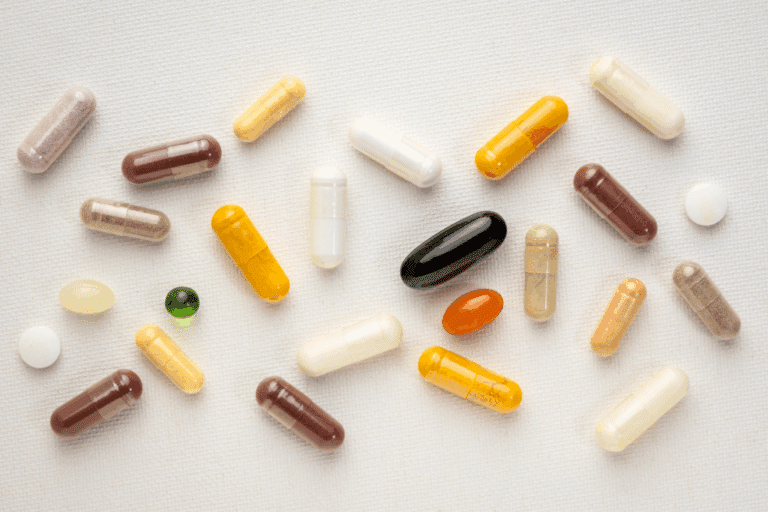Jennifer is a 45-year-old yoga instructor/mother of 3. A self-proclaimed “Type A,” she finds irony in choosing yoga as her profession. Jen’s overall physical and mental well-being is very healthy, so it was a shock when her healthcare provider found her to have “high cholesterol” during her yearly exam.
Many perimenopausal women, like Jennifer, do not have their cholesterol levels checked frequently, so they may have no clue that they already have borderline risky cholesterol levels BEFORE going through menopause.
Understanding Cholesterol
Cholesterol is in every cell of your body. Your body either makes it or absorbs it from food. Cholesterol is vital for your body because you need it to make steroid hormones such as estrogen, progesterone, and vitamin D. It is also used to make bile acids in the liver, which help absorb fat during digestion.
SOME cholesterol in the body is good, but high levels of LDL and triglycerides can increase the risk of heart disease. Both can contribute to plaques in your arteries, which can progress to full-blown blockages over time. These blockages are the primary cause of heart attacks and strokes.
Is LDL Cholesterol REALLY Bad?
Whether or not LDL is dangerous is highly dependent on other factors. Health issues related to LDL depend on the amount of inflammation and oxidative stress in your body. And inflammation depends on other factors such as blood sugar control, stress, antioxidant status, immune system strength, detoxification capability, gut health, nutrient sufficiency, and activity level. Studies show that over half the people in the hospital having had a heart attack had “optimal” LDL levels prior to the event.
A test called the coronary calcium score can help determine whether high LDL is becoming a problem. Studies have shown that the coronary calcium scan better predicts coronary events than cholesterol screening or other risk factor assessments.
Advanced lipid testing can also be helpful. It looks at the particle size and density of cholesterol. Smaller, dense particles more readily contribute to the development of plaques and are increased by carbohydrate consumption (as are triglycerides). On the other hand, large, fluffy cholesterol particles do little to contribute to the risk of heart disease.
These advanced tests and coronary scans aren’t without controversy, and insurance doesn’t always cover them for people without symptoms of heart disease. But they are becoming more mainstream.
HDL Cholesterol… Is More Better?
HDL cholesterol does provide a protective effect against LDL because it transports the LDL out of circulation back to the liver. In this process, it rescues damaged LDL particles that can be plaque-causing.
However, when HDL becomes higher than 100, it can be too much of a good thing. Oxidative stress can damage HDL, which can thus become part of atherosclerotic plaques. When this happens, tests such as hs-CRP (a marker for inflammation) and 8-OHDG (a marker of oxidative stress) can help further clarify whether high HDL is a problem.
What Cholesterol Levels Are Healthy?
What are the target numbers for cholesterol? It can vary by disease state, but for an average healthy woman, you should aim for the following:
- LDL cholesterol less than 130 mg/dL unless you have heart disease, diabetes, or more than two risk factors…then it’s 100 (and possibly less than 70 mg/dL)
In addition to high LDL, atherosclerosis, or diabetes, other important risk factors for heart disease are:
- Cigarette smoking
- High blood pressure (140/90 mm Hg and above or on blood pressure medication)
- Low HDL cholesterol
- Family history of early coronary heart disease
- Age (for men, age 45 or older; for women, age 55 or older)
2. HDL cholesterol around 50mg/dl or higher (but not too high!)
3. Triglycerides less than 150 mg/dl. As an FYI, high triglycerides are more of a marker for high blood sugar than problem cholesterol. Get a fasting insulin level checked if yours are high.
4. Total cholesterol well below 200 mb/dL
(Peri)Menopause and Cholesterol
Many women are unaware that they are at risk for cardiovascular problems. As you move toward menopause and estrogen levels fall, cholesterol increases, as does the risk of heart disease and stroke.
The good news is you can take steps to prevent this from becoming a problem.
Tips for Healthy Cholesterol
- Eat a heart-healthy diet, focusing on fruits, vegetables, lean protein, and high amounts of soluble fiber.
- Exercise for at least 30 minutes five or more days per week.
- Don’t smoke.
- Maintain a healthy weight.
- Drink alcohol in moderation, especially if your triglycerides are high.
- Eat monosaturated and polyunsaturated fats. Good examples would be those found in olive oil, nuts, and fatty fish like salmon.
- Medicate if necessary. Depending on your overall heart disease risk (calculate yours here), you may need to be treated with a cholesterol-lowering medication, such as a statin, niacin, or herbal cholesterol-lowering product such as bergamot or red yeast rice. Fish oil can also be beneficial for lowering triglycerides.
Perimenopause is a time of significant change. Even if you think you are healthy, like Jennifer, there may be hidden risks of heart disease hiding in your body. Know your numbers and take a deep dive, if necessary, to assess your actual risk.
Dr. Anna Garrett is a menopause expert and Doctor of Pharmacy. She helps women who are struggling with symptoms of perimenopause and menopause find natural hormone balancing solutions so they can rock their mojo through midlife and beyond. Dr. Anna is the author of Perimenopause: The Savvy Sister’s Guide to Hormone Harmony. Order your copy at www.perimenopausebook.com.
Also, she offers a membership group, Hormone Harmony with Dr. Anna Garrett, which provides women in midlife with affordable expert guidance and community support.
Dr. Anna is available for 1-1 consultation. Find out more at www.drannagarrett.com/lets-




